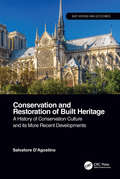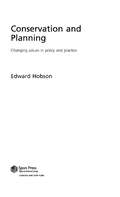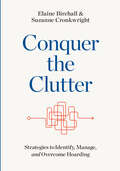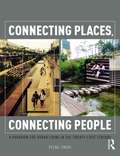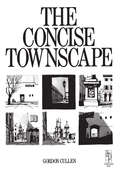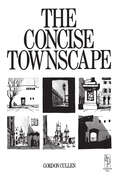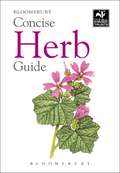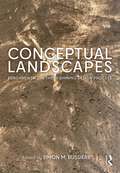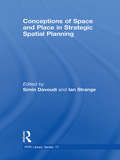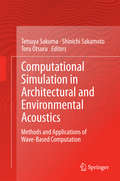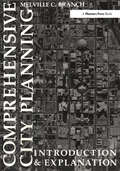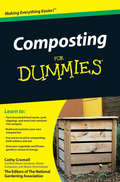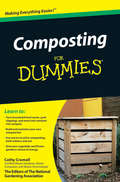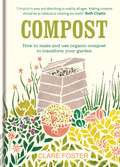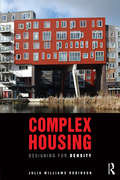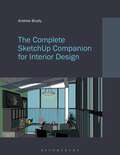- Table View
- List View
Conservation and Restoration of Built Heritage: A History of Conservation Culture and its More Recent Developments (Built Heritage and Geotechnics)
by Salvatore D'AgostinoThe word conservation, when used in the context of the preservation of built heritage, implies an intrinsically complex concept that evolved over time, since it has been influenced by the perception of history throughout time. This volume emphasises why an understanding of the cultural evolution of the conservation approach must be considered a prerequisite for architects and engineers if they are to cooperate in full harmony with historic-artistic culture for the preservation of global built heritage. In particular, the volume highlights how, during the second half of the last century, the preservation process also involved engineering – the science of making practical applications of knowledge – which, for a long time, made an uncritical use of techniques and materials and devised interventions on historical heritage that were heavily invasive. The volume also devotes special attention to the problems related to seismic risk, to which Italy, Greece and Portugal are particularly prone. Problems that emerge during the crisis and reconstruction phases are dealt with in detail, as is scheduled maintenance, as this latter approach always constitutes an improvement in the performance of the monument and is the most appropriate tool for the conservation of the built heritage. Finally, the volume collects examples of building restoration with case studies of many outstanding monuments. The work will appeal to professionals and academics in the broader fields of civil engineering (both geotechnical and structural engineering), architecture, art history, the history of architecture, restoration and cultural heritage management. This book will: Provide a critical reading of the history of conservation; Discuss materials and techniques of ancient architecture; Cover seismic vulnerability and preservation of the historic integrity of the monument; Advocate an approach based on programmed maintenance; Feature numerous case histories, including St Mark’s Basilica in Venice and the complex restoration of the cathedral of Notre-Dame in Paris.
Conservation and Planning: Changing Values in Policy and Practice
by Edward HobsonConserving historic buildings continues to excite and inflame opinion. The means of protecting such buildings and areas are well established but frequently suffer a lack of wider understanding. Conservation and Planning takes a detailed look at the way these processes have evolved and their use today by policy makers and local decision makers.This book presents original research into how national and local decision-makers construct and implement conservation of the built environment. The findings in this book challenge many of the assumptions supporting conservation.
Conservation and Planning: Changing Values in Policy and Practice
by Edward HobsonConserving historic buildings continues to excite and inflame opinion. The means of protecting such buildings and areas are well established but frequently suffer a lack of wider understanding. Conservation and Planning takes a detailed look at the way these processes have evolved and their use today by policy makers and local decision makers.This book presents original research into how national and local decision-makers construct and implement conservation of the built environment. The findings in this book challenge many of the assumptions supporting conservation.
Conquer the Clutter: Strategies to Identify, Manage, and Overcome Hoarding
by Elaine Birchall Suzanne CronkwrightWhy does Cliff, a successful lawyer who regularly wins landmark cases, step over two-foot piles of paper whenever he opens his front door? Why do Joan and Paul ask Children's Services to take their three children instead of decluttering their home? Why does Lucinda feel intense pressure to hold onto her family's heirlooms even though she has no room for them? They have hoarding disorder, which an estimated 2% to 6% of the adult population worldwide experience.Conquer the Clutter offers hope to anyone affected by hoarding. Real-life vignettes, combined with easy-to-use assessment and intervention tools, support those who hoard—and those who care about them. Written by Elaine Birchall, a social worker dedicated to helping people declutter and achieve long-term control over their belongings, the book• provides an overview of hoarding, defining what it is—and is not• explains the difference between clutter and hoarding • describes different types of hoarding in detail, including impulse shopping, "closet" hoarding, and animal hoarding• debunks myths about hoarding and hoarders • explores the effects that hoarding has on relationships, on work, and on physical and financial health• presents a practical, step-by-step plan of action for decluttering• contains dedicated advice from individuals who have successfully overcome their hoarding disorderThe most comprehensive work about hoarding on the market, Conquer the Clutter discusses special populations who are not often singled out, such as the disabled and the elderly, and includes numerous worksheets to assist individuals in determining the scope of their hoarding disorder and tackling the problem.
Conquer the Clutter: Strategies to Identify, Manage, and Overcome Hoarding
by Elaine Birchall Suzanne CronkwrightWhy does Cliff, a successful lawyer who regularly wins landmark cases, step over two-foot piles of paper whenever he opens his front door? Why do Joan and Paul ask Children's Services to take their three children instead of decluttering their home? Why does Lucinda feel intense pressure to hold onto her family's heirlooms even though she has no room for them? They have hoarding disorder, which an estimated 2% to 6% of the adult population worldwide experience.Conquer the Clutter offers hope to anyone affected by hoarding. Real-life vignettes, combined with easy-to-use assessment and intervention tools, support those who hoard—and those who care about them. Written by Elaine Birchall, a social worker dedicated to helping people declutter and achieve long-term control over their belongings, the book• provides an overview of hoarding, defining what it is—and is not• explains the difference between clutter and hoarding • describes different types of hoarding in detail, including impulse shopping, "closet" hoarding, and animal hoarding• debunks myths about hoarding and hoarders • explores the effects that hoarding has on relationships, on work, and on physical and financial health• presents a practical, step-by-step plan of action for decluttering• contains dedicated advice from individuals who have successfully overcome their hoarding disorderThe most comprehensive work about hoarding on the market, Conquer the Clutter discusses special populations who are not often singled out, such as the disabled and the elderly, and includes numerous worksheets to assist individuals in determining the scope of their hoarding disorder and tackling the problem.
Connecting Places, Connecting People: A Paradigm for Urban Living in the 21st Century
by Reena TiwariWhat is a better community? How can we reconfigure places and transport networks to create environmentally friendly, economically sound, and socially just communities? How can we meet the challenges of growing pollution, depleting fossil fuels, rising gasoline prices, traffic congestion, traffic fatalities, increased prevalence of obesity, and lack of social inclusion? The era of car-based planning has led to the disconnection of people and place in developed countries, and is rapidly doing so in the developing countries of the Global South. The unfolding mega-trend in technological innovation, while adding new patterns of future living and mobility in the cities, will question the relevance of face-to-face connections. What will be the ‘glue’ that holds communities together in the future? To build better communities and to build better cities, we need to reconnect people and places. Connecting Places, Connecting People offers a new paradigm for place making by reordering urban planning principles from prioritizing movement of vehicles to focusing on places and the people who live in them. Numerous case studies, including many from developing countries in the Global South, illustrate how this can be realized or fallen short of in practical terms. Importantly, citizens need to be engaged in policy development, to connect with each other and with government agencies. To measure the connectivity attributes of places and the success of strategies to meet the needs, an Audit Tool is offered for a continual quantitative and qualitative evaluation.
Connecting Places, Connecting People: A Paradigm for Urban Living in the 21st Century
by Reena TiwariWhat is a better community? How can we reconfigure places and transport networks to create environmentally friendly, economically sound, and socially just communities? How can we meet the challenges of growing pollution, depleting fossil fuels, rising gasoline prices, traffic congestion, traffic fatalities, increased prevalence of obesity, and lack of social inclusion? The era of car-based planning has led to the disconnection of people and place in developed countries, and is rapidly doing so in the developing countries of the Global South. The unfolding mega-trend in technological innovation, while adding new patterns of future living and mobility in the cities, will question the relevance of face-to-face connections. What will be the ‘glue’ that holds communities together in the future? To build better communities and to build better cities, we need to reconnect people and places. Connecting Places, Connecting People offers a new paradigm for place making by reordering urban planning principles from prioritizing movement of vehicles to focusing on places and the people who live in them. Numerous case studies, including many from developing countries in the Global South, illustrate how this can be realized or fallen short of in practical terms. Importantly, citizens need to be engaged in policy development, to connect with each other and with government agencies. To measure the connectivity attributes of places and the success of strategies to meet the needs, an Audit Tool is offered for a continual quantitative and qualitative evaluation.
Concise Townscape
by Gordon CullenThis book pioneered the concept of townscape. 'Townscape' is the art of giving visual coherence and organization to the jumble of buildings, streets and space that make up the urban environment. It has been a major influence on architects, planners and others concerned with what cities should look like.
Concise Townscape
by Gordon CullenThis book pioneered the concept of townscape. 'Townscape' is the art of giving visual coherence and organization to the jumble of buildings, streets and space that make up the urban environment. It has been a major influence on architects, planners and others concerned with what cities should look like.
Concise Herb Guide
by BloomsburyThis beautifully illustrated mini field guide is packed with information on the most common herbs from around the world. Many of these plants grow wild in Britain and other parts of Europe, and can also be cultivated in gardens. The guide additionally includes exotic but commonly used species such as Vanilla, Cloves, Cinnamon and Star-anise.More than 180 herbs are included, all of which are illustrated with superb full-colour artworks that show details of the flowers and leaves, roots and bark where applicable, and growth habit of each plant. A concise written account covering culinary, medicinal and other uses, size, description, habitat and distribution appears on the same page.The easy-to-follow layouts and superb artworks aid quick and accurate identification, making this book an indispensable reference in the field as well as at home. It is compact enough to fit in the pocket, yet packed with essential information. To protect it against the elements in the field, the book is wrapped in a durable plastic wallet. Also included is a fold-out insert with at-a-glance illustrations showing herbs grouped by colour.Renowned natural history artists Christine Hart-Davis, Bridgette James and David Sutton painted the illustrations.
Concise Herb Guide
by BloomsburyThis beautifully illustrated mini field guide is packed with information on the most common herbs from around the world. Many of these plants grow wild in Britain and other parts of Europe, and can also be cultivated in gardens. The guide additionally includes exotic but commonly used species such as Vanilla, Cloves, Cinnamon and Star-anise.More than 180 herbs are included, all of which are illustrated with superb full-colour artworks that show details of the flowers and leaves, roots and bark where applicable, and growth habit of each plant. A concise written account covering culinary, medicinal and other uses, size, description, habitat and distribution appears on the same page.The easy-to-follow layouts and superb artworks aid quick and accurate identification, making this book an indispensable reference in the field as well as at home. It is compact enough to fit in the pocket, yet packed with essential information. To protect it against the elements in the field, the book is wrapped in a durable plastic wallet. Also included is a fold-out insert with at-a-glance illustrations showing herbs grouped by colour.Renowned natural history artists Christine Hart-Davis, Bridgette James and David Sutton painted the illustrations.
Conceptualist Landscapes: An Alternative Way to Design Gardens (Workshops on Garden Design)
by Paul CooperConceptual gardens depend on inspiration which is the result of an exhaustive intellectual process. The starting point is an IDEA or stimulus that pushes the design along, rather than observing more conventional styles - whether classical of modernist - into which idea or relationships are fitted. Horticultural considerations, architectural or aesthetic doctrines and practically-based problem-solving are either abandoned or regarded as a means to an end, rather than the end in itself. Idea-driven design, therefore, cannot be taught by a 'rule-of-thumb' methodology. So, the way to design a conceptualist garden is not the theme of this book; nor does it contain 'of-the-peg' solutions for garden and landscape designers. Rather it encourages student and professional designers to think further towards their designed solutions.
Conceptual Landscapes: Fundamentals in the Beginning Design Process
by Simon M. BussiereConceptual Landscapes explores the dilemma faced in the early moments of design thinking through a gradient of work in landscape and environmental design media by both emerging and well-established designers and educators of landscape architecture. It questions where and, more importantly, how the process of design starts. The book deconstructs the steps of conceptualizing design in order to reignite pedagogical discussions about timing and design fundamentals, and to reveal how the spark of an idea happens – from a range of unique perspectives. Through a careful arrangement of visual essays that integrate analog, digital, and mixed-media works and processes, the book highlights differences between diverse techniques and triggers debate between design, representation, technology, and creative culture in the field. Taken together, the book’s visual investigation of the conceptual design process serves as a learning tool for aspiring designers and seasoned professionals alike. By situating student work alongside that of experienced teachers and landscape architects, the book also demystifies outdated notions of individual genius and sheds new light on the nearly universally messy process of discovery, bridged across years and diverse creative vocabularies in the conceptual design process. Lavishly illustrated with over 210 full color images, this book is a must-read for students and instructors in landscape architecture.
Conceptual Landscapes: Fundamentals in the Beginning Design Process
Conceptual Landscapes explores the dilemma faced in the early moments of design thinking through a gradient of work in landscape and environmental design media by both emerging and well-established designers and educators of landscape architecture. It questions where and, more importantly, how the process of design starts. The book deconstructs the steps of conceptualizing design in order to reignite pedagogical discussions about timing and design fundamentals, and to reveal how the spark of an idea happens – from a range of unique perspectives. Through a careful arrangement of visual essays that integrate analog, digital, and mixed-media works and processes, the book highlights differences between diverse techniques and triggers debate between design, representation, technology, and creative culture in the field. Taken together, the book’s visual investigation of the conceptual design process serves as a learning tool for aspiring designers and seasoned professionals alike. By situating student work alongside that of experienced teachers and landscape architects, the book also demystifies outdated notions of individual genius and sheds new light on the nearly universally messy process of discovery, bridged across years and diverse creative vocabularies in the conceptual design process. Lavishly illustrated with over 210 full color images, this book is a must-read for students and instructors in landscape architecture.
Conceptions of Space and Place in Strategic Spatial Planning (RTPI Library Series)
by Simin Davoudi Ian StrangeBringing together authors from academia and practice, this book examines spatial planning at different places throughout the British Isles. Six illustrative case studies of practice examine which conceptions of space and place have been articulated, presented and visualized through the production of spatial strategies. Ranging from a large conurbation (London) to regional (Yorkshire and Humber) and national levels, the case studies give a rounded and grounded view of the physical results and the theory behind them. While there is widespread support for re-orienting planning towards space and place, there has been little common understanding about what constitutes ‘spatial planning’, and what conceptions of space and place underpin it. This book addresses these questions and stimulates debate and critical thinking about space and place among academic and professional planners.
Conceptions of Space and Place in Strategic Spatial Planning (RTPI Library Series)
by Simin Davoudi Ian StrangeBringing together authors from academia and practice, this book examines spatial planning at different places throughout the British Isles. Six illustrative case studies of practice examine which conceptions of space and place have been articulated, presented and visualized through the production of spatial strategies. Ranging from a large conurbation (London) to regional (Yorkshire and Humber) and national levels, the case studies give a rounded and grounded view of the physical results and the theory behind them. While there is widespread support for re-orienting planning towards space and place, there has been little common understanding about what constitutes ‘spatial planning’, and what conceptions of space and place underpin it. This book addresses these questions and stimulates debate and critical thinking about space and place among academic and professional planners.
Computational Simulation in Architectural and Environmental Acoustics: Methods and Applications of Wave-Based Computation
by Tetsuya Sakuma Shinichi Sakamoto Toru OtsuruThis book reviews a variety of methods for wave-based acoustic simulation and recent applications to architectural and environmental acoustic problems.Following an introduction providing an overview of computational simulation of sound environment, the book is in two parts: four chapters on methods and four chapters on applications. The first part explains the fundamentals and advanced techniques for three popular methods, namely, the finite-difference time-domain method, the finite element method, and the boundary element method, as well as alternative time-domain methods. The second part demonstrates various applications to room acoustics simulation, noise propagation simulation, acoustic property simulation for building components, and auralization.This book is a valuable reference that covers the state of the art in computational simulation for architectural and environmental acoustics.
Comprehensive City Planning: Introduction & Explanation
by Melville BranchThe author’s classic text focuses on the development of cities and how they have been planned and managed through the ages. The tie between land use and municipal administration is explored throughout. Topics include the roots of city management and planning; physical and socioeconomic views of cities; how city planning works within city government; the ties between planning and city politics; zoning and urban design; new towns; and regional planning. This work is the culmination of the author's long career in planning practice. His involvement in government, business, and academics means this book relates to a wide variety of fields. And the author writes in a clear, nontechnical style. Whether you're a city official, a professional, or a concerned citizen, you'll find this a cohesive, readable, and authoritative introduction to the field of planning.
Comprehensive City Planning: Introduction & Explanation
by Melville BranchThe author’s classic text focuses on the development of cities and how they have been planned and managed through the ages. The tie between land use and municipal administration is explored throughout. Topics include the roots of city management and planning; physical and socioeconomic views of cities; how city planning works within city government; the ties between planning and city politics; zoning and urban design; new towns; and regional planning. This work is the culmination of the author's long career in planning practice. His involvement in government, business, and academics means this book relates to a wide variety of fields. And the author writes in a clear, nontechnical style. Whether you're a city official, a professional, or a concerned citizen, you'll find this a cohesive, readable, and authoritative introduction to the field of planning.
Composting For Dummies
by Cathy Cromell The National Gardening AssociationBack-to-basics gardening that will benefit the earth and your wallet! Want to use ordinary waste to create an extraordinary garden? Composting lets you turn household food waste, yard clippings, and more into free compost and mulch that's chock-full of nutrients. From building and working with traditional compost bins to starting an indoor worm-composting operation, Composting For Dummies makes these often intimidating projects easy, fun, and accessible for anyone! Digging into compost basics — get a handle on the benefits of composting and the tools you'll need to get started Choosing the best method and location — find the best composting method and location that's right for you, whether it's above ground, in a hole, in a container or bin, or even right in your kitchen Building your pile — learn which ingredients can go into your compost pile, what stays out, and how to mix it all up in the right proportions Stepping beyond traditional composting — get the lowdown on vermicomposting (letting worms eat your garbage), growing green manures to compost later, and sheet composting in the same spot you plan to plant Open the book and find: A step-by-step guide to composting The right gear and tools for the job Tips on constructing your own composting containers and bins Materials you can safely compost (and those to avoid) Cover crops to improve your soil now and compost later Recommendations for using your finished compost What worms contribute to your compost Troubleshooting advice if your compost pile isn't cooperating Learn to: Turn household food waste, yard clippings, and more into nutrient-rich compost Build and maintain your own compost bin Use worms to aid in composting, both indoors and out Give your vegetable and flower gardens a boost of energy
Composting For Dummies
by Cathy Cromell The National Gardening AssociationBack-to-basics gardening that will benefit the earth and your wallet! Want to use ordinary waste to create an extraordinary garden? Composting lets you turn household food waste, yard clippings, and more into free compost and mulch that's chock-full of nutrients. From building and working with traditional compost bins to starting an indoor worm-composting operation, Composting For Dummies makes these often intimidating projects easy, fun, and accessible for anyone! Digging into compost basics — get a handle on the benefits of composting and the tools you'll need to get started Choosing the best method and location — find the best composting method and location that's right for you, whether it's above ground, in a hole, in a container or bin, or even right in your kitchen Building your pile — learn which ingredients can go into your compost pile, what stays out, and how to mix it all up in the right proportions Stepping beyond traditional composting — get the lowdown on vermicomposting (letting worms eat your garbage), growing green manures to compost later, and sheet composting in the same spot you plan to plant Open the book and find: A step-by-step guide to composting The right gear and tools for the job Tips on constructing your own composting containers and bins Materials you can safely compost (and those to avoid) Cover crops to improve your soil now and compost later Recommendations for using your finished compost What worms contribute to your compost Troubleshooting advice if your compost pile isn't cooperating Learn to: Turn household food waste, yard clippings, and more into nutrient-rich compost Build and maintain your own compost bin Use worms to aid in composting, both indoors and out Give your vegetable and flower gardens a boost of energy
Compost: How to make and use organic compost to transform your garden
by Clare FosterIn this new edition of her hands-on guide to the art of composting, House & Garden garden editor, Clare Foster, shows you how to build a compost box, select the best ingredients and put the resulting organic compost to the best use in your outdoor space.By taking some dead leaves, grass cuttings and old banana skins and enlisting the help of bacteria, insects and nature, you can improve and enrich your soil, feed your plants and nourish your vegetables, restoring the natural balance of life in your garden.
Complex Housing: Designing for Density
by Julia Williams RobinsonComplex Housing introduces an architectural type called complex housing, common to the Netherlands and found in other Northern European countries. Eight fully illustrated case studies show successful approaches to designing for density, which reflect values such as long-term planning, a right to housing, and access to light and air. The case studies demonstrate a wide range of applications including a mixture of urban and suburban sites, various numbers of dwelling units, low- to high-density approaches, different architectural styles, and organizational strategies that can be adopted in projects elsewhere. More than 350 color images.
Complex Housing: Designing for Density
by Julia Williams RobinsonComplex Housing introduces an architectural type called complex housing, common to the Netherlands and found in other Northern European countries. Eight fully illustrated case studies show successful approaches to designing for density, which reflect values such as long-term planning, a right to housing, and access to light and air. The case studies demonstrate a wide range of applications including a mixture of urban and suburban sites, various numbers of dwelling units, low- to high-density approaches, different architectural styles, and organizational strategies that can be adopted in projects elsewhere. More than 350 color images.
The Complete SketchUp Companion for Interior Design: - with STUDIO
by Andrew BrodyThe Complete SketchUp Companion for Interior Design focuses on the skills and requirements necessary to design and explore interiors-from composing views to managing the structure of the model for tracking objects in schedules and keys. Organized by skill type, the book mimics the layered nature of the software, where a general base skill set is enhanced and deepened through more advanced, focused explorations and exercises. With concise explanations, and helpful boxed features ranging from basic to advanced topics, The Complete SketchUp Companion for Interior Design will be equally useful for beginning users and for those who already have knowledge of basic skills but find themselves in common “I-need-to-know” type situations in the design studio.The Complete SketchUp® Companion for Interior Design STUDIO-Study smarter with self-quizzes featuring scored results and personalized study tips-Review concepts with flashcards of terms and definitions-Watch video tutorials to learn essential techniques -Download template files to practice your skillsPLEASE NOTE: Purchasing or renting this ISBN does not include access to the STUDIO resources that accompany this text. To receive free access to the STUDIO content with new copies of this book, please refer to the book + STUDIO access card bundle ISBN 9781501322006.
